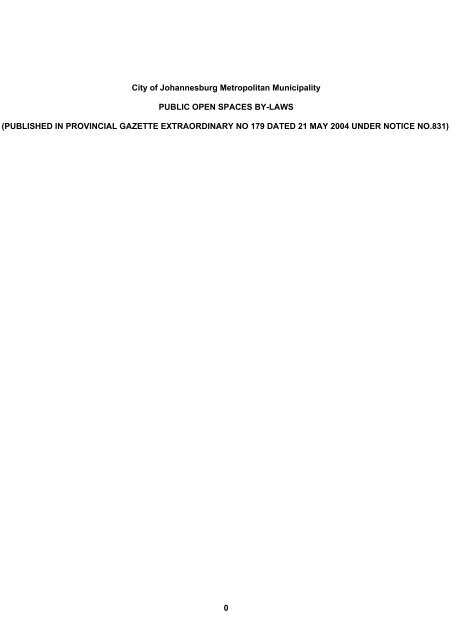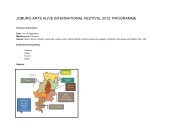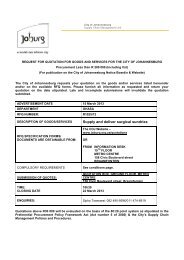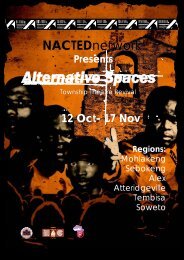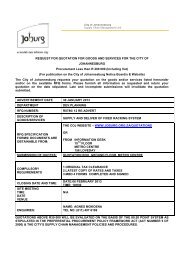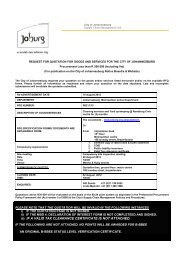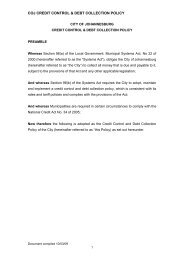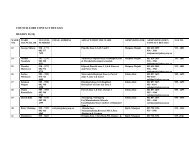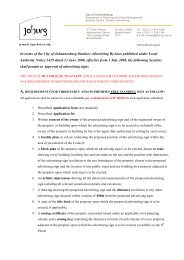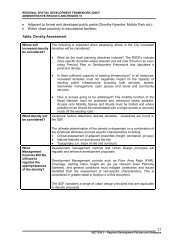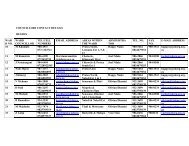Public Open Spaces By-laws - Johannesburg City Parks
Public Open Spaces By-laws - Johannesburg City Parks
Public Open Spaces By-laws - Johannesburg City Parks
You also want an ePaper? Increase the reach of your titles
YUMPU automatically turns print PDFs into web optimized ePapers that Google loves.
<strong>City</strong> of <strong>Johannesburg</strong> Metropolitan MunicipalityPUBLIC OPEN SPACES BY-LAWS(PUBLISHED IN PROVINCIAL GAZETTE EXTRAORDINARY NO 179 DATED 21 MAY 2004 UNDER NOTICE NO.831)0
Definitions and interpretationCHAPTER 1INTERPRETATION AND FUNDAMENTAL PRINCIPLES1. (1) In these <strong>By</strong>-<strong>laws</strong>, unless the context otherwise indicates –“active game” means any physical sport, game or other activity participated in byone or more persons which is undertaken within a public open space other than inan area set aside for that purpose, and which may cause injury to other users ofthe public open space, a nuisance or damage to vegetation or municipal propertywithin a public open space and includes rugby, golf, archery, football, tennis,badminton, hockey, netball, volleyball, skate-boarding, roller-skating and in-lineskating;“authorised official” means any official of the Council who has been authorised bythe Council to administer, implement, and enforce the provisions of these <strong>By</strong><strong>laws</strong>;“conservation public open space” means public open space which is managed byor on behalf of the Council for conservation purposes, and includes any naturereserve, greenbelt, ravine, bird sanctuary and site of historic, ecological orarchaeological value;“Council” means –(a) the Metropolitan Municipality of the <strong>City</strong> of <strong>Johannesburg</strong> established byProvincial Notice No 6766 of 2000 dated I October 2000, as amended,exercising its legislative and executive authority through its municipalCouncil; or(b) its successor in title; or(c) a structure or person exercising a delegated power or carrying out aninstruction, where any power in these by-<strong>laws</strong> has been delegated or subdelegated,or an instruction given, as contemplated in section 59 of theLocal Government: Municipal Systems Act, 2000 (Act No 32 of 2000); or(d) a service provider fulfilling a responsibility under these by-<strong>laws</strong>, assigned toit in terms of section 81(2) of the Local Government: Municipal Systems Act(Act No. 32 of 2000) or any other law, as the case may be.“designated area” means an area designated by the Council as an area in whichan active game or any other activity or conduct, which would otherwise beprohibited under Chapter 3 of these <strong>By</strong>-<strong>laws</strong>, may be undertaken;“environment” means the surroundings within which humans exist and that aremade up of –3
(a)(b)(c)(d)the land, water and atmosphere of the earth;micro-organisms, plant and animal life;any part or combination of paragraphs (a) and (b) and the interrelationshipsamong and between them; andthe physical, chemical, aesthetic and cultural properties and conditions ofthe foregoing that influence human health and well-being;“environmentally sustainable” means the exercising of any decision-makingpowers or performance of any activities in a manner aimed at ensuring that –(a) the risk of harm to the environment and to human health and safety isminimised to the extent reasonably possible under the circumstances;(b) the potential benefits to the environment and to human health and safety aremaximised to the extent reasonably possible under the circumstances; and(c) legislation intended to protect the environment and human health and safetyis complied with;“local community” means that body of persons comprising –(a)(b)(c)the residents of the area in which a public open space is situated;the ratepayers of the area in which a public open space is situated; andany civic organisation and non-governmental or private sector organisationor body which are involved in local affairs in the area in which a public openspace is situated;“municipal manager” means a person appointed as such by the Council in termsof section 82 of the Local Government: Municipal Structures Act, 1998 (Act No117 of 1998);“municipal property” means any structure or thing owned or managed by or onbehalf of the Council and which is incidental to the use and enjoyment of a publicopen space and includes any building, lapa, kiosk, bench, picnic table, playgroundequipment, fountain, statue, monument, fence, pole, notice and sign;“notice” means a clear and legible official notice drawn up by the Council inEnglish and Afrikaans and prominently displayed in a public open space;“nuisance” means an unreasonable interference or likely interference with–(a)(b)(c)the health or well-being of any person;the use and enjoyment by an owner or occupier of his or her property; orthe use and enjoyment by a member of the public of a public open space;“organ of State” means –(a)any department of State or administration in the national, provincial or localsphere of government; and(b) any other functionary or institution –(i)exercising a power or performing a function in terms of the Constitutionof the Republic of South Africa Act, 1996 (Act No. 108 of 1996) or aprovincial Constitution; or4
(ii)exercising a public power or performing a public function in terms ofany legislation, but does not include a court of law and a judicialofficer;“person” means a natural person or a juristic person, and includes an organ ofState;“prescribed fee” means a fee determined by the Council by resolution in terms ofsection 10G(7)(a)(ii) of the Local Government Transition Act, 1993 (Act No. 209 of1993), or any other applicable legislation;“printed matter” includes any advertisement, billboard, poster, book, pamphlet orhandbill;“prohibited activity” means any activity or behaviour which is prohibited in terms ofChapter 3 from being undertaken in a public open space, either completely orwithout permission in terms of section 21, 22 or 23;“public open space” means any land which –(a) is owned by an organ of State, or(b) over which an organ of State has certain real rights arising from the filing inthe Deeds Office or other registration office of a general plan of a township,agricultural holding or other division of land, or any alteration, addition to oramendment of such land approved by the Surveyor-General, on which ismarked the land to which the public has a common right of use; and(c) is controlled and managed by the Council; and(d) is either –(i)(ii)set aside in terms of any law, zoning scheme or spatial plan, for thepurpose of public recreation, conservation, the installation of publicinfrastructure or agriculture; orpredominantly undeveloped and open and has not yet been set asidefor a particular purpose in terms of any law, zoning scheme or spatialplan;“public utility public open space” means public open space which is managed byor on behalf of the Council for the purposes of providing a public service, whichincludes road reserves and areas subject to electrical, pipeline and other publicutility servitudes, but excludes council housing, clinics and other social services;“recreational public open space” means public open space which is managed byor on behalf of the Council for public recreational purposes, and includes anypark, botanical garden, sportsground and playground, but excludes any golfcourse;“road reserve” means that portion of a road, street or thoroughfare improved,constructed or intended for vehicular traffic and which is between the edges of theroadway and that portion of a road, street or thoroughfare, including the sidewalk,which is not the roadway or shoulder;“special event” means a parade, procession, race, concert, show, exhibition,festival, ceremony, film shoot, photographic shoot or similar event, which requires,for that purpose, exclusive use of a part of a public open space;5
“urban agricultural public open space” means public open space which ismanaged by or on behalf of the Council for urban agricultural purposes;“vehicle” means a device designed or adapted mainly to travel on wheels, butexcludes a wheelchair and children’s pushchair and perambulator;“waste” means any substance or article which a person wishes to dispose ofbecause it is unwanted, superfluous, broken, worn out, contaminated or otherwisespoilt and that has been discarded or has been accumulated or stored so that itcan be discarded, reused, reclaimed or recycled;“watercraft” includes any boat, raft, yacht, canoe, inflatable mattress, model shipor boat, radio-controlled boat or similar device;“water body” means any body of water within a public open space and includes apond, fountain, artificial watercourse, dam, lake, canal, reservoir, stream, riverand wetland.(2) If any provision in these <strong>By</strong>-<strong>laws</strong> vests or imposes any power, function or duty ofthe Council in or on an employee of the Council and such power, function or dutyhas in terms of section 81(2) of the Local Government: Municipal systems Act,2000, or any other law been assigned to a service provider, the reference in suchprovision to such employee must be read as a reference to the service provideror, where applicable, an employee of the service provider authorised by it.Application of <strong>By</strong>-<strong>laws</strong>2. (1) These <strong>By</strong>-<strong>laws</strong> apply to every public open space which falls under the jurisdictionof the Council, but do not apply to cemeteries.(2) These <strong>By</strong>-<strong>laws</strong> are binding on the State.Purpose of <strong>By</strong>-<strong>laws</strong>3. The purpose of these <strong>By</strong>-<strong>laws</strong> is to provide, in conjunction with other applicablelegislation, an effective legal and administrative framework-(a)(b)to ensure that the way in which the Council controls, manages and developspublic open spaces is environmentally sustainable, and is in the long-terminterests of the whole community of <strong>Johannesburg</strong>, including future generations;andwhich clearly defines the rights and obligations of the public in relation to publicopen spaces.CHAPTER 2MANAGEMENT AND ADMINISTRATION OF PUBLIC OPEN SPACESPrinciples of <strong>By</strong>-<strong>laws</strong>4. (1) <strong>Public</strong> open spaces must be managed, and where appropriate developed, in theinterests of the whole community, and in determining the interests of the wholecommunity –6
(a) the long-term collective interests of the people of <strong>Johannesburg</strong>, and ofSouth Africa, must be prioritised over the interests of any specific interestgroup or sector of society;(b) a long-term perspective, which takes account the interests of futuregenerations, must be adopted; and(c) the interests of other living organisms which depend on public open spacesmust be taken into account.(2) <strong>Public</strong> open spaces must be managed in an environmentally sustainable manner.(3) Subject to the provisions of subsection (5) and section 7, people must be givenaccess to public open spaces on a non-discriminatory and equitable basis.(4) If necessary, special measures must be taken to facilitate access to public openspaces by historically disadvantaged persons and by disabled persons.(5) Access to a public open space may be restricted in a manner which does notunjustifiably discriminate against any person or class of persons–(a) if the restriction is authorised by these <strong>By</strong>-<strong>laws</strong> or by any other law; or(b) in order to achieve the purposes of these <strong>By</strong>-<strong>laws</strong>.(6) The recreational, educational, social and other opportunities which public openspaces offer must be protected and enhanced to enable local communities,particularly historically disadvantaged communities, and the public to improve andenrich their quality of life.(7) Local communities must be encouraged to use and care for public open spaces intheir areas.(8) The natural environment and heritage resources within public open spaces mustbe identified, preserved, protected and promoted, for the benefit of the localcommunity, the public and future generations.7
Application of principles5. The public open space management principles set out in section 4, and the nationalenvironmental management principles set out in section 2 of the NationalEnvironmental Management Act, 1998 (Act 107 of 1998), must be considered andapplied by any person –(a)(b)(c)exercising a power or function or performing a duty under these <strong>By</strong>-<strong>laws</strong>;formulating or implementing any policy which is likely to have a significant effecton, or which concerns the use of, public open spaces within the Council’sjurisdiction; orexercising a public power or function or performing a public duty which is likely tohave a significant effect on, or which concerns the use of, public open spaces.General powers of Council6. The Council may in relation to any public open space –(a)(b)(c)(d)designate any area within a public open space as an area within which one ormore activities otherwise prohibited in terms of these <strong>By</strong>-<strong>laws</strong> may be undertaken,and display a prominent notice to this effect at every entrance to the designatedarea;develop any public open space in accordance with the principles set out in section4;erect, construct, establish or demolish municipal property; andexercise any other power reasonably necessary for the discharge of the Council’sobligations in terms of these <strong>By</strong>-<strong>laws</strong> relating to the management of public openspaces.Fees7. Any member of the public must pay –(a)(b)(c)(d)(e)(f)(g)a prescribed fee to use recreational or other facilities which the Council provideswithin any public open space;a prescribed fee for entrance to any public open space which is significantly moreexpensive to maintain than other public open spaces, such as botanical gardens;a prescribed fee for the right to undertake a special event;a prescribed fee for the right to exclusively use municipal property for a specificperiod;a deposit prior to undertaking a prohibited activity permitted by the Council;an annual or monthly fee for the right to use urban agricultural public open spaceto the exclusion of any other person; anda prescribed fee for processing applications for permits or letters of permissionunder these <strong>By</strong>-<strong>laws</strong>,if such a fee or deposit has been determined by the Council.8
Restricting access8. The Council may restrict access to any public open space or to any part of a publicopen space for a specified period of time –(a)(b)(c)(d)(e)(f)to protect any aspect of the environment within a public open space;to reduce vandalism and the destruction of property;to improve the administration of a public open space;to develop a public open space;to enable a special event which has been permitted in terms of section 22, toproceed; orto undertake any activity which the Council reasonably considers necessary orappropriate to achieve the purposes of these <strong>By</strong>-<strong>laws</strong>.Powers of authorised officials9. In relation to any public open space, an authorized official may –(a) to the extent authorised by the Council administer, implement and enforce theprovisions of these <strong>By</strong>-<strong>laws</strong>;(b) issue a notice in terms of section 20;(c) instruct any person to leave a public open space if the authorized officialreasonably believes that the person is contravening any provision of these <strong>By</strong><strong>laws</strong>,and fails to immediately terminate such contravention upon the instruction ofthat official; and(d) if such official is a peace officer, exercise any power which may be exercised by apeace officer under the Criminal Procedure Act, 1977 (Act No. 51 of 1977).Obligations in relation to public open spaces10. (1) The Council must within a public open space display any notice required underthese <strong>By</strong>-<strong>laws</strong>.(2) In relation to recreational public open spaces, the Council must –(a) ensure that they are open to the public between sunrise and sunset, unlessspecified otherwise in terms of a notice; and(b) prominently display a notice at every entrance indicating:(i)(ii)the opening and closing times of that recreational public open space;andany rules made by the Council in relation to that recreational publicopen space.9
CHAPTER 3PROHIBITED CONDUCTProhibited activities11. (1) Any person who undertakes an activity or behaves in a manner that is prohibitedin terms of these <strong>By</strong>-<strong>laws</strong>, commits an offence unless, in addition to anyexceptions contained in sections 12 to 19, that activity or conduct–(a) takes place in a designated area within which that activity or conduct isallowed; or(b) is authorised in terms of a permission granted or permit issued in terms ofsection 21, 22 or 23; or(c) is deemed to be authorised by the Council under subsection (2).(2) Subject to the provisions of subsection (3), a person is not in contravention of anyprovision of section 12 to 19 if that person needs to undertake the prohibitedactivity –(a) to perform his or her obligations as an employee, agent or contractor of theCouncil under his or her contract with, or mandate from, the Council or toachieve the purposes of these <strong>By</strong>-<strong>laws</strong>;(b) to carry out public duties as an employee, agent or contractor of an organ ofState within a public open space which is subject to a public utility servitudein favour of that organ of State;(c) to fulfil his or her duties as an authorised official; or(d) to fulfill his or her duties as a peace officer.(3) Subsection (2) must not be interpreted to allow a contravention of section 12(a) or(e) or any activity which the Council has expressly refused to permit.General prohibition12. No person may within a public open space –(a)(b)(c)(d)(e)act in a manner which is dangerous to life or property;contravene the provisions of any notice within any public open space;unlawfully enter a public open space to which access has been restricted in termsof section 8;cause a nuisance; orbehave in an indecent or offensive manner.Prohibited use13. No person may within a public open space –(a) bathe, wade, or swim in or wash him- or herself, an animal or any object,including clothing, in any water body;(b) make, light or otherwise start a fire except in a facility provided by the Council forthat purpose;(c)(d)camp or reside;consume, brew, store or sell any alcoholic beverage;10
(e)(f)(g)use any sound equipment, including a radio, portable hi-fi or car stereo;play an active game, except in an area designated for that purpose on a sportplaying field or on a golf course; orshoot a projectile of any nature.Waste14. No person may within a public open space –(a)(b)deposit, dump or discard any waste, other than in a receptacle provided by theCouncil for that purpose; orpollute or deposit any waste or thing in a manner which may detrimentally impacton a water body.Vehicles15. No person may within a public open space –(a) except at times specified and on roads or pathways provided by the Council,drive, draw or propel any vehicle other than a bicycle;(b) drive, draw or propel a vehicle in excess of five kilometres per hour; or(c) park a vehicle in a public open space, except in designated area or other areawhere parking is otherwise permitted by the Council.Vegetation and animals16. (1) Subject to the provisions of subsection (2), no person may within a public openspace –(a) disturb, damage, destroy or remove any tree, shrub or other vegetation;(b) affix or place any printed matter on a tree;(c) plant any vegetation;(d) alter the slope or drainage pattern so as to interfere with the access of water,air or nutrients to any tree or other plant;(e) capture or attempt to capture, chase, shoot at, injure, throw objects at, tease,molest or in any other way disturb any animal, fish, or bird;(f) disturb, damage or destroy any bird nest or egg;(g) ride a horse, except-(i) in a public open space or any part thereof designated by the Councilfor that purpose; and(ii) a person who in the performance of his or her official duties, patrolsa public open space on horseback;(h) walk, carry, ride or bring an animal other than a horse or dog; or(i) walk any dog unless-(i)(ii)it is in a public open space or any part thereof which has not beendesignated by the Council as an area where no dogs are allowed, andit is on a leash and under control of a person; orit is in a public open space or any part thereof designated by theCouncil as an area where dogs may run free:11
Provided that if any dog excretes in a public open space, the person incontrol of the dog must immediately remove such excrement and dispose ofit in a waste bin or other receptacle provided by the Council for that purpose.(2) The provisions of subsection (1)(a) and (c) do not apply to any person who hasobtained a permit in terms of section 23 to undertake agricultural activities in anurban agricultural public open space.Municipal property and erection of structures17. (1) Subject to the provisions of subsection (2), no person may within a public openspace –(a) deface, damage, destroy or remove any municipal property;(b) disturb the surface of any land, whether by digging, undertaking anyearthworks or otherwise;(c) erect, build or assemble any structure, including a hut, tent, screen, bulletinboard, pole, stand or stage;(d) affix or place on any municipal property, or distribute, any printed matter; or(e) plug, tamper with, or in any way damage any plumbing, electrical, heating orother fixtures or installations.(2) The provisions of subsection (1)(b) do not apply to any person who has obtaineda permit in terms of section 23 to undertake agricultural activities in an urbanagricultural public open space.Selling and special events18. (1) No person may within a public open space –(a)(b)use municipal property in a way that unfairly restricts or prevents other usersof the public open space from enjoying that municipal property; orexcept within a public open space or part thereof, which has been let to aperson by the Council for that purpose, sell, hawk, offer or display anygoods or articles for sale or hire;(2) No person may undertake a special event, except in terms of a permit issued interms of section 22.Community service19. Except in terms of an agreement entered into in terms of section 24, no person maywithin a public open space undertake any community or voluntary work of anydescription.12
(2) The time period referred to in subsection (1) may, on good cause shown, bereduced by the Council.(3) An application in terms of subsection (1), must contain the following information:(a)(b)(c)(d)The name and full contact details of the applicant, including name, postaladdress, telephone and fax numbers and email address, if available;the nature and purpose of the special event;the intended route or area proposed to be used for purposes of the specialevent; andany permission required under Chapter 3 of these <strong>By</strong>-<strong>laws</strong>.(4) Subject to any permit conditions imposed by the Council, the holder of a specialevents permit has the right to use the area of public open space specified in thepermit to the exclusion of any other person during the period specified in thepermit.Application for permission to farm in an urban agricultural public open space23. (1) An application for permission to farm in an urban agricultural public open spacemust contain the following information:(a)(b)(c)The name and full contact details of the applicant, including name, postaladdress, telephone and fax numbers and email address, if available;the nature of the agricultural activity that the applicant proposes toundertake; andthe size and location of the area on which the applicant wishes to undertakethe proposed agricultural activity.(2) A permit under this section may require the permit holder to pay an annual ormonthly fee for the use of the land.(3) The holder of an urban agricultural permit may, subject to any condition specifiedin the permit, use the area of public open space specified in the permit foragricultural purposes to the exclusion of any other person.14
Entering into agreementsCHAPTER 5CO-OPERATIVE MANAGEMENT AGREEMENTS24. (1) The Council may enter into a written agreement with any organ of State, localcommunity or organization to provide for –(a)(b)(c)he co-operative development of any public open space; orthe co-operative management of any public open space; andthe regulation of human activities within a public open space.(2) The Council may not enter into an agreement in terms of subsection (1) (b) unlessit reasonably believes that entering into such an agreement will promote thepurpose of these <strong>By</strong>-<strong>laws</strong>.(3) The Council must monitor the effectiveness of any agreement entered into interms of subsection (1), in achieving the purposes for which it was entered intoand may cancel the agreement after giving reasonable notice to the other party ifthe Council has reason to believe that the agreement is not effective, or isinhibiting the attainment of the purpose of these <strong>By</strong>-<strong>laws</strong>.GeneralCHAPTER 6TREE PRESERVATION ORDERS25. (1) If the Council believes that any tree or group of trees in a public open spacerequires legal protection the Council may issue a tree preservation order inrespect of that tree or group of trees.(2) A tree preservation order-(a) must indicate the tree or trees to which it relates; and(b) may provide that any person who cuts, disturbs, damages, destroys,removes, transports, exports, purchases, sells, donates or in any othermanner acquires or disposes of the tree or trees to which it relates, commitsan offence.(3) The Council must prominently display a copy of a tree preservation order issuedwithin 3 metres of the tree or trees to which the order relates.Procedure26. Unless, in the Council’s opinion, the issuing of a tree preservation order is required as amatter of urgency, the Council must, before issuing a tree preservation order in terms ofsection 25–15
(a) give notice of the proposal to protect the tree or group of trees and invitecomments and objections within a specified period, by publishing a notice in theProvincial Gazette and in two newspapers circulating in the area in which the treeor group of trees is situated;(b) notify any affected organs of State; and(c) consider any comments and objections received in response to the notice.CHAPTER 7MISCELLANEOUSOffences and penalties27. (1) Any person who –(a)(b)(c)(d)contravenes or fails to comply with any provisions of these <strong>By</strong>-<strong>laws</strong>;fails to comply with any notice or other document issued or displayed interms of these <strong>By</strong>-<strong>laws</strong>;fails to comply with any lawful instruction given in terms of these <strong>By</strong>-<strong>laws</strong>; orobstructs or hinders any authorised official in the execution of his or herduties under these <strong>By</strong>-<strong>laws</strong>is guilty of an offence and liable on conviction to a fine or in default of payment toimprisonment for a period not exceeding six months and in the case of acontinuing offence, to a further fine not exceeding R50, or in default of payment toimprisonment not exceeding one day, for every day during the continuance ofsuch offence after a written notice has been issued by the Council and served onthe person concerned requiring the discontinuance of such offence.Repeal28. The <strong>laws</strong> listed in Schedule 1 to these <strong>By</strong>-<strong>laws</strong> are hereby repealed.Short Title29. These <strong>By</strong>-<strong>laws</strong> are called the <strong>Public</strong> <strong>Open</strong> <strong>Spaces</strong> <strong>By</strong>-<strong>laws</strong>, 2003.16
SCHEDULE 1REPEALED BY-LAWSNumber and Year Name of <strong>By</strong>-<strong>laws</strong> Extent of RepealAdministrator’s Notice 50dated 23 January 1963Transvaal Board for theDevelopment of Peri-UrbanAreas: <strong>By</strong>-<strong>laws</strong> Relating to <strong>Parks</strong>,Gardens, Pleasure Resorts and<strong>Open</strong> <strong>Spaces</strong> as applied byWholeAdministrator’s Notice 166dated 2 February 1972Administrator’s Notice1540 dated 4 September1974Administrator’s Notice2176 dated 28 November1984Local Authority Notice 365dated 23 January 1991Midrand Municipality<strong>Johannesburg</strong> Municipality: <strong>Parks</strong>,Gardens and <strong>Open</strong> <strong>Spaces</strong> <strong>By</strong><strong>laws</strong>Randburg Municipality: <strong>By</strong>-<strong>laws</strong>for the Regulation of <strong>Public</strong>AmenitiesRoodepoort Municipality: <strong>By</strong>-<strong>laws</strong>for the Regulation of <strong>Parks</strong>, <strong>Open</strong><strong>Spaces</strong>, Dams and ConservationAreasSandton Municipality: Adoption ofStandard <strong>Public</strong> Amenities <strong>By</strong><strong>laws</strong>WholeWholeWholeWhole17


